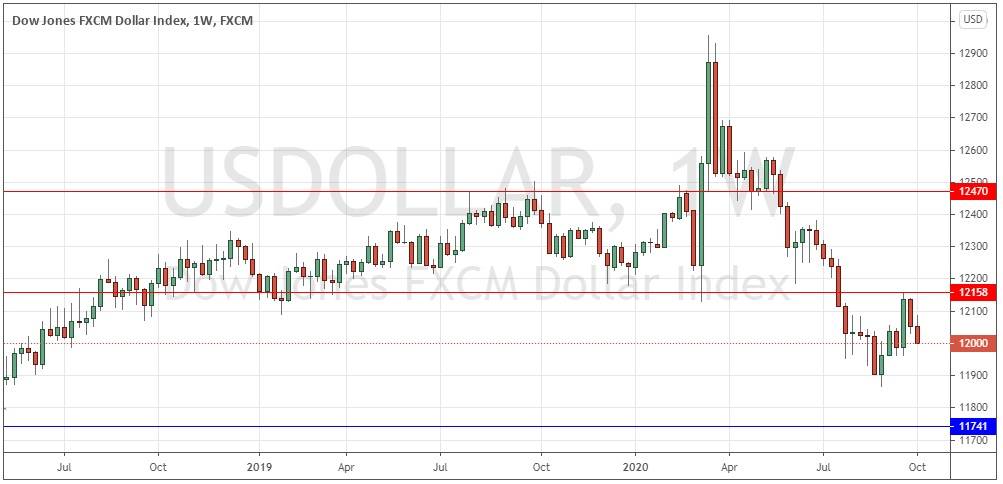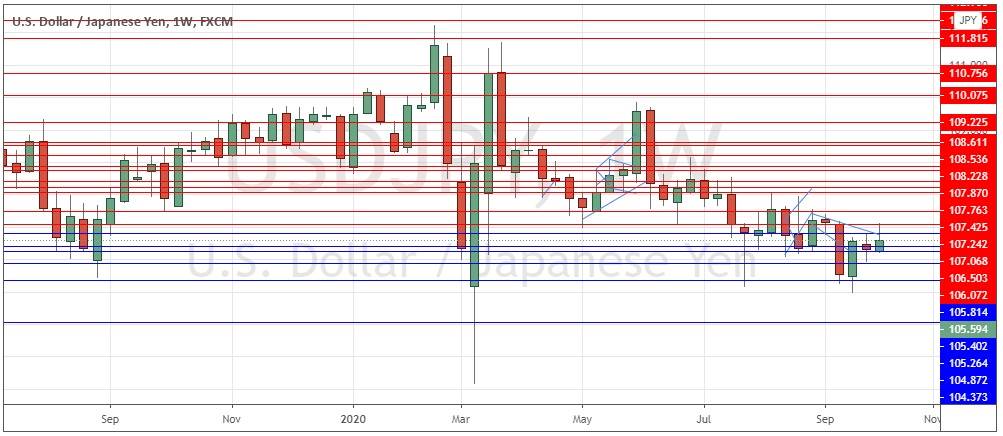The difference between success and failure in Forex trading is very likely to depend mostly upon which currency pairs you choose to trade each week and in which direction, and not on the exact trading methods you might use to determine trade entries and exits. The current market environment is still one of crisis, with a questionable rebound as global stock market indices recovered to reach new all-time highs before correcting, despite the continuing spread of the coronavirus pandemic which is still sweeping the world.
Big Picture 11th October 2020
In my previous piece last week, I saw the most attractive trade opportunities as likely to be short-term short trades in the USD/JPY currency pair. This was a good call as the USD/JPY currency pair ended the week down by 0.72%.
Last week’s Forex market saw the strongest rise in the relative value of the Canadian Dollar and the strongest fall in the relative value of the U.S. Dollar.
Fundamental Analysis & Market Sentiment
The focus now of stock market analysts in the U.S. is centered partially on the potential outcome of the U.S. Presidential election on 3rd November, and progress towards a deal between House Democrats and the Trump administration on a further round of economic stimulus which is widely seen as necessary to reignite economic recovery from the coronavirus shock earlier in the year. President Trump first announced he would not pursue such an agreement, then later backtracked somewhat, which saw stocks recover from their dip.
Markets appear to be largely unconcerned with the result of the U.S. Presidential election, having already priced in a likely Biden victory which is forecast by all major opinion pollsters. Some analysts take a contrarian view that the polls severely underestimate the President’s support. Betting markets are increasingly predicting a more comfortable Biden victory and markets seem quite comfortable with that, probably because Biden is seen as a centrist and because a Democrat clean sweep would make a stimulus package likely to happen quickly and in good size.
The U.S. stock market has continued to recover more strongly after correcting from its recent all-time high. Most analysts see the correction as nothing out of the ordinary as stock markets had been making a parabolic rise for some time.
Last week saw very strong Canadian employment data, which boosted the Canadian Dollar. Canadian fundamentals have been turning much more positive over recent months.
We have seen the number of new confirmed cases reported daily globally in the global coronavirus pandemic remain high, with the highest ever daily total of new cases reported last Friday. Globally, coronavirus deaths are relatively lower than they were during their peak in early April, suggesting the virus may have become less lethal, or medical systems have effectively improved their treatment capacities. However, a worrying development has come in the form of a strong rise in new daily cases within the European Union and the United Kingdom over recent weeks, not to mention the enormous number of new confirmed cases which are being seen currently every day in India (currently running at approximately 70,000 per day). The European Union is now reporting fewer daily cases than only one other country, India.
Yesterday saw the highest daily coronavirus death toll in India, at approximately 900 deaths.
Latin America is responsible for approximately 36% of confirmed new daily deaths, with India at 18%, the U.S.A. at 13% and Europe (including the U.K.) at about 15%. The strongest growth in new confirmed cases is happening in Argentina, Armenia, Austria, Bahamas, Belgium, Bosnia, Bulgaria, Burma, Canada, Colombia, Costa Rica, Croatia, Cyprus, Czech Republic, Ecuador, Georgia, Germany, Greece, Guatemala, Hungary, Iceland, Indonesia, Iran, Italy, Jordan, Kenya, Latvia, Lebanon, Lithuania, Malaysia, Malta, Moldova, Morocco, Nepal, Netherlands, North Macedonia, Norway, Paraguay, Poland, Portugal, Romania, Russia, Serbia, Slovakia, Slovenia, Switzerland, Tunisia, U.S.A., Ukraine, the U.A.E., and the United Kingdom.
The coming week is likely to bring a similar level of activity in the Forex market to what was seen last week. We will be getting U.S. inflation and retail sales data as well as Australian employment numbers.
Technical Analysis
U.S. Dollar Index
The weekly price chart below shows the U.S. Dollar index printed another bearish candlestick. It closed right on the low of its range, which is a bearish sign, and there is a long-term bearish trend, as the price is lower than it was both 3 and 6 months ago. Overall, next week’s price movement in the U.S. Dollar looks likely to be downwards due to the prevalent trend and other bearish signs.
USD/JPY
The USD/JPY currency pair is in a long-term downwards trend but rose slightly last week, albeit with a weakly bullish candlestick with a large upper wick. The Dollar itself is in a downwards trend yet few currencies currently look strong against it. The bearish trend here is slow but persistent. A further fall over the coming week is more likely than not to happen. The problem with shorting the U.S. Dollar against other currencies right now is that there are few strong currencies that are not close to firm long-term resistance or support levels which may well block further strong movement in the near term.
S&P 500 Index
The major U.S. stock market index, the S&P 500, is clearly in a bull market. It briefly declined by about 10% from its all-time high before rebounding, and the bullish rebound finally saw some real bullish momentum over the course of the past week. The Dollar itself is in a downwards trend which should help the price rise further, and with the strong bullish momentum, it is likely we will see still higher prices over the coming few days if not the entire week.
Bottom Line
I see the best likely opportunities in the financial markets this week in looking for short-term short trades in the USD/JPY currency pair and short-term long trades in the S&P 500 Index.




